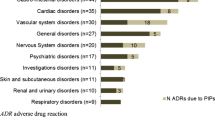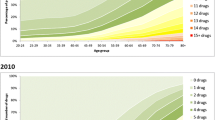Abstract
Background and objective
Inappropriate prescribing is an important and possibly preventable risk factor for adverse drug reactions (ADRs) in the elderly, and hospital-based studies have shown that a large proportion of admissions is a result of ADRs. However, little is known about how inappropriate drug use (IDU) affects the elderly at the population level. The aim of this study was to explore possible associations of IDU with acute hospitalisation and mortality in an elderly population during 3 years of follow-up.
Patients and methods
Data from a rural, population-based, longitudinal cohort study within the Kungsholmen Project, Sweden, were used. 785 participants, ≥75 years of age, had complete data on drug use and selected covariates collected during baseline investigation from 1995 to 1998, and were included in the study. Hospitalisation and mortality data during 3 years after inclusion were collected. IDU was assessed at baseline using consensus-based criteria applicable to available data (derived from Beers’ criteria, Canadian criteria and clinical indicators of drug-related morbidity in older adults) with the addition of potentially dangerous drug duplication and additional potentially hazardous drug-drug interactions. IDU was defined as presence of at least one inappropriate drug regimen according to the study criteria. Logistic regression and proportional hazard models were used, respectively, to study the association of IDU with hospitalisation and mortality.
Results
Drugs were used on a regular or ‘as needed’ basis by 91.6% of the study population, with a mean of 4.4 drugs per person. IDU was common, with a prevalence of 18.6% and was associated with increased risk of at least one acute hospitalisation in community-living elderly, after adjustment for age, sex, education, comorbidity, dependency in activities of daily living (ADL) and smoking. The odds ratio was 2.72 (95% CI 1.64, 4.51). No association with mortality was found, after adjustment for age, sex, housing, education, comorbidity, ADL-dependency, smoking and body mass index.
Conclusion
Polypharmacy and IDU are common among the elderly and IDU is associated with acute hospitalisation in community-living elderly. Although causality cannot be established with this study design, the results are consistent with the high prevalence of drug-related hospital admissions found in hospital-based studies. Our results indicate that it is desirable with current knowledge, to reduce IDU through information to physicians and careful prescribing.





Similar content being viewed by others
Notes
The use of trade names is for product identification purposes only and does not imply endorsement.
References
Lindley CM, Tully MP, Paramsothy V, et al. Inappropriate medication is a major cause of adverse drug reactions in elderly patients. Age Ageing 1992; 2: 294–300
Aparasu RR, Mort JR. Inappropriate prescribing for the elderly: Beers criteria-based review. Ann Pharmacother 2000 Mar; 34: 338–46
Giron MST, Wang HX, Bernsten C, et al. The appropriateness of drug use in an older nondemented and demented population. J Am Geriate Soc 2001; 49(3): 277–83
Hanlon JT, Schmader KE, Boult C, et al. Use of inappropriate prescription drugs by older people. J Am Geriate Soc 2002; 50(1): 26–34
Liu GG, Christensen DB. The continuing challenge of inappropriate prescribing in the elderly: an update of the evidence. J Am Pharm Assoc (Wash) 2002; 42(6): 847–57
Beijer HJM, de Blaey CJ. Hospitalisations caused by adverse drug reactions (ADR): a meta-analysis of observational studies. Pharm World Sci 2002; 24(2): 46–54
Atkin PA, Veitch PC, Veitch EM, et al. The epidemiology of serious adverse drug reactions among the elderly. Drugs Aging 1999; 14(2): 141–52
Stewart RB, Cooper JW. Polypharmacy in the aged: practical solutions. Drugs Aging 1994; 4(6): 449–61
Stuck AE, Beers MH, Steiner A, et al. Inappropriate medication use in community-residing older persons. Arch Intern Med 1994; 154: 2195–200
Spore DL, Mor V, Larrat P, et al. Inappropriate drug prescriptions for elderly residents of board and care facilities. Am J Public Health 1997; 87(3): 404–9
Rochon PA, Gurwitz JH. Optimising drug treatment for elderly people: the prescribing cascade. BMJ 1997; 315(7115): 1096–9
Buajordet I, Ebbesen J, Erikssen J, et al. Fatal adverse drug events: the paradox of drug treatment. J Intern Med 2001; 250: 327–41
Shelton PS, Fritsch MA, Scott MA. Assessing medication appropriateness in the elderly: a review of available measures. Drugs Aging 2000; 16(6): 437–50
Hanlon JT, Fillenbaum GG, Kuchibhatla M, et al. Impact of inappropriate drug use on mortality and functional status in representative community dwelling elders. Med Care 2002; 40(2): 166–76
Fillenbaum GG, Hanlon JT, Landerman LR, et al. Impact of inappropriate drug use on health services utilization among representative older community-dwelling residents. Am J Geriate Pharmacother 2004; 2(2): 92–101
Gupta S, Rappaport HM, Bennett LT. Inappropriate drug prescribing and related outcomes for elderly Medicaid beneficiaries residing in nursing homes. Clin Ther 1996; 18(1): 183–96
Chin MH, Wang LC, Jin L, et al. Appropriateness of medication selection for older persons in an urban academic emergency department. Acad Emerg Med 1999; 6(12): 1232–42
Aparasu RR, Mort JR. Prevalence, correlates and associated outcomes of potentially inappropriate psychotropic use in the community-dwelling elderly. Am J Geriate Pharmacother 2004; 2(2): 102–11
Fu AZ, Liu GG, Christensen DB. Inappropriate medication use and health outcomes in the elderly. J Am Geriate Soc 2004; 52(11) 1934–9
Fratiglioni L, Viitanen M, Backman L, et al. Occurrence of dementia in advanced age: the study design of the Kung-sholmen Project. Neuroepidemiology 1992; 11Suppl. 1: 29–36
Klarin I, Fastbom J, Wimo A. A population-based study of drug use in the very old living in a rural district of Sweden, with focus on cardiovascular drug consumption: comparison with an urban cohort. Pharmacoepidemiol Drug Saf 2003; 12: 669–78
WHO Collaborating Centre for Drug Statistics and Methodology. Guidelines for ATC classification and DDD assignment. Oslo, Norway: World Health Organization, 1995
Beers MH. Explicit criteria for determining potentially inappropriate medication use by the elderly: an update. Arch Intern Med 1997 Jul 28; 157: 1531–6
McLeod PJ, Huang AR, Tamblyn RM, et al. Defining inappropriate practices in prescribing for elderly people: a national consensus panel. CMAJ 1997; 156(3): 385–91
Robertson HA, MacKinnon NJ. Development of a list of consensus-approved clinical indicators of preventable drug-related morbidity in older adults. Clin Ther 2002; 24(10): 1595–613
Sjöqvist F. Drug interactions [in Swedish]. In: FASS. Läkemedel i Sverige. Forteckning over humanläkemedel. Stockholm, Sweden: LINFO Läkemedelsinformation AB, 1997: 1220–73
Leipzig RM, Cumming RG, Tinetti ME. Drugs and falls in older people: a systematic meta-analysis. I: psychotropic drugs. J Am Geriate Soc 1999; 47(1): 30–9
Moore AR, O’Keeffe ST. Drug-induced cognitive impairment in the elderly. Drugs Aging 1999; 15(1): 15–28
Miller EA, Weissert WG. Predicting elderly people’s risk for nursing home placement, hospitalization, functional impairment, and mortality: a synthesis. Med Care Res Rev 2000, 97
Charlson ME, Pompei P, Ales KL, et al. A new method of classifying prognostic comorbidity in longitudinal studies: development and validation. J Chronic Dis 1987; 40(5): 373–83
Deyo RA, Cherkin DC, Ciol MA. Adapting a clinical comorbidity index for use with ICD-9-CM administrative databases. J Clin Epidemiol 1992; 45(6): 613–9
Buntinx F, Niclaes L, Suetens C, et al. Evaluation of Charlson’s comorbidity index in elderly living in nursing homes. J Clin Epidemiol 2002; 55: 1144–7
Bravo G, Dubois MF, Réjean H, et al. A prospective evaluation of the Charlson comorbidity index for use in long-term care patients. J Am Geriate Soc 2002; 50(4): 740–5
Cockcroft DW, Gault MH. Prediction of creatinine clearance from serum creatinine. Nephron 1976; 16: 31–41
Jassal V, Fillit H, Oreopoulos DG. Diseases of the aging kidney. In: Tallis R, Fillit H, Brocklehurst JC, editors. Brocklehurst’s textbook of geriatric medicine and gerontology. 5th ed. London: Churchill Livingstone, 1998: 949–71
Flodin L, Svensson S, Cederholm T. Body mass index as a predictor of 1 year mortality in geriatric patients. Clin Nutr 2000; 19(2): 121–5
Grabowski DC, Ellis JE. High body mass index does not predict mortality in older people: analysis of the longitudinal study of aging. J Am Geriate Soc 2001; 49(7): 968–79
Katz S, Ford AB, Moskowitz RW, et al. Studies of illness in the aged. The index of ADL: a standardized measure of biological and psychosocial function. JAMA 1963; 185(12): 914–9
Jörgensen TM, Isacsson DGL, Thorslund M. Prescription drug use among ambulantory eldery in a Swedish municipality. Ann Pharmacother 1993 Sep; 27: 1120–5
Chen Y-F, Dewey ME, Avery AJ, et al. Self-reported medication use for older people in England and Wales. J Clin Pharm Ther 2001; 26: 129–40
Lassila HC, Stoehr GP, Ganguli M, et al. Use of prescription medications in an elderly rural population: the MoVIES project. Ann Pharmacother 1996 Jun; 30: 589–95
Biverkningsrapportering i Sverige 1998 [in Swedish]. Information från Läkemedelsverket (Information from the Medical Product Agency, Sweden) 1999; 10(4): 23 [online]. Available from URL: http://www.mpa.se/biverkningar/biv99/bivtabell_-i.htm. [Accessed 2004 Nov 21]
Table 60: population by sex, marital status and age by single years. In: Statistical yearbook of Sweden. Örebro, Sweden: Statistics Sweden, 2000: 57–8
Freeman G, Hjortdahl P. What future for continuity of care in general practice? BMJ 1997; 314(7098): 1870–3
Piecoro LT, Browning SR, Prince TS, et al. A database analysis of potentially inappropriate drug use in an elderly Medicaid population. Pharmacotherapy 2000; 20(2): 221–8
Dhalla IA, Anderson GM, Mamdani MM, et al. Inappropriate prescribing before and after nursing home admission. J Am Geriate Soc 2002; 50(6): 995–1000
Hanlon JT, Fillenbaum GG, Schmader KE, et al. Inappropriate drug use among community-dwelling elderly. Pharmacotherapy 2000; 20(5): 575–82
Stuart B, Coulson NE. Dynamic aspects of prescription drug use in an elderly population. Health Serv Res 1993; 28: 237–64
Garrard J, Dunham T, Makris L, et al. Longitudinal study of psychotropic drug use by elderly nursing home residents. J Gerontol 1992; 47(6): M183–8
Hanlon JT, Schmader KE, Ruby CM, et al. Suboptimal prescribing in older inpatients and outpatients. J Am Geriate Soc 2001; 49(2): 200–9
Acknowledgements
This study was supported by The National Board of Health and Welfare, Sweden; Forum for Research and Development (FOU-forum), The County Council of Gävleborg, Sweden; The Federation of Swedish County Councils (Landstingsförbundet), Sweden, Dnr 1297/00; The National Corporation of Swedish Pharmacies’ Fund for Research and Studies in Health Economics and Social Pharmaceutics (Stiftelsen Apoteksbolagets fond för forskning och studier i hälsoekonomi och socialfarmaci), Sweden.
The authors have no conflicts of interest directly relevant to this review.
Author information
Authors and Affiliations
Corresponding author
Rights and permissions
About this article
Cite this article
Klarin, I., Wimo, A. & Fastbom, J. The Association of Inappropriate Drug Use with Hospitalisation and Mortality. Drugs Aging 22, 69–82 (2005). https://doi.org/10.2165/00002512-200522010-00005
Published:
Issue Date:
DOI: https://doi.org/10.2165/00002512-200522010-00005




